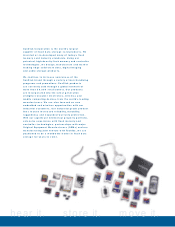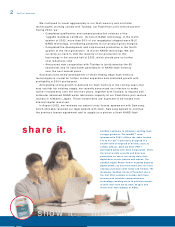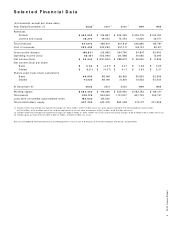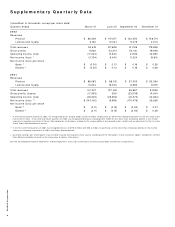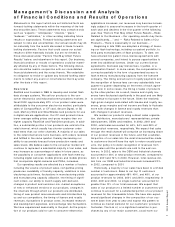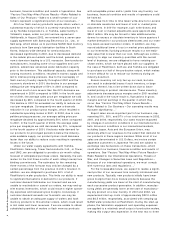SanDisk 2002 Annual Report Download - page 10
Download and view the complete annual report
Please find page 10 of the 2002 SanDisk annual report below. You can navigate through the pages in the report by either clicking on the pages listed below, or by using the keyword search tool below to find specific information within the annual report.
8 Sa nDisk C o rp ora tio n
business, financial condition and results of operations. See
“Factors That M ay Affect Future Results – Risks Related to
Sales of Our Products – Sales to a small number of cus-
tom ers represent a significant portion of our revenues….”
All of our flash m emory products require silicon w afers, a
substantial m ajority of w hich is currently m anufactured for
us by Toshiba Corporation’s, or Toshiba, w afer facility in
Yokkaichi, Japan, under our joint venture agreem ent.
Additionally, in August 2002, w e entered into a seven-year
supply agreem ent w ith Sam sung Electronics Co., Ltd., or
Sam sung, w hich allow s us to purchase NAND flash mem ory
products from Samsung’s fabrication facilities in South
Korea. Industry-w ide dem and for sem iconductors
decreased significantly in 2001, due to decreased dem and
in the cellular phone m arkets and the broad, general eco-
nom ic dow nturn leading to a U.S. recession. Semiconductor
m anufacturers, including som e of our suppliers and com -
petitors, added new advanced w afer fabrication capacity
prior to the downturn. This additional capacity, along with
slow ing econom ic conditions, resulted in excess supply and
led to intense pricing pressure. Due to the oversupply of
flash m em ory foundry capacity throughout 2001 and the
econom ic slow dow n in 2001, the decline in our average
selling price per m egabyte of 50% in 2001 com pared to
2000 w as m uch m ore severe than the 22% decrease w e
experienced in 2000 compared to 1999. In the fourth quar-
ter of 2001, the average sales price per m egabyte w e sold
decreased by 68% compared to the fourth quarter of 2000.
This decline in 2001 far exceeded our ability to reduce our
cost per m egabyte. Consequently w e saw a dram atic
reduction in our product gross m argins, w hich resulted in
substantial operating losses in 2001. In 2002, due to com -
petitive pricing pressures, our average selling price per
m egabyte declined by approxim ately 50% w hen compared
to 2001. In the fourth quarter of 2002, the average sales
price per m egabyte w e sold decreased by 31%, com pared
to the fourth quarter of 2001. If industry-w ide dem and for
our products for prolonged periods is below the industry-
w ide available supply, our product prices could decrease
faster than our ability to reduce costs resulting in operating
losses in the future.
Under our w afer supply agreements w ith Toshiba,
FlashVision, Sam sung, Tower Sem iconductor Ltd., or Tower,
and UM C, w e are obligated to provide a six-m onth rolling
forecast of anticipated purchase orders. Generally, the esti-
m ates for the first three m onths of each rolling forecast are
binding comm itm ents. The estim ates for the remaining
three m onths of the forecast m ay only be changed by a
certain percentage from the previous m onth’s forecast. In
addition, w e are obligated to purchase 50% of all of
FlashVision’s w afer production. This lim its our ability to react
to significant fluctuations in dem and for our products. If
custom er dem and falls below our forecast and we are
unable to reschedule or cancel our orders, w e m ay end up
w ith excess inventories, w hich could result in higher operat-
ing expenses and reduced gross m argins. Conversely, if
custom er dem and exceeds our forecasts, w e m ay be
unable to obtain an adequate supply of w afers and flash
m em ory products to fill custom er orders, w hich could result
in lost sales and low er revenues. If w e are unable to obtain
scheduled quantities of w afers or flash m emory products
w ith acceptable prices and/or yields from any foundry, our
business, financial condition and results of operations could
be harm ed.
We have from time to tim e taken w rite-dow ns for excess
or obsolete inventories and low er of cost or m arket price
adjustm ents. In 2001 for exam ple, such write-dow ns and
low er of cost or m arket adjustm ents w ere approxim ately
$85.0 m illion. We m ay be forced to take additional w rite-
downs for excess or obsolete inventory in future quarters if
m arket dem and for our products deteriorates and our inven-
tory levels exceed custom er orders. In addition, w e m ay
record additional low er of cost or m arket price adjustm ents
to our inventories if pricing pressure results in a net realiz-
able value that is low er than our cost. Although w e continu-
ously try to align our inventory quantities w ith the current
level of business, w e are obligated to honor existing pur-
chase orders, w hich w e have placed w ith our suppliers. In
the case of FlashVision, both w e and Toshiba are obligated
to purchase our half of the production output, w hich m akes
it m ore difficult for us to reduce our inventory during an
industry dow nturn.
Excess inventory not only ties up our cash, but also
can result in substantial losses if such inventory, or large
portions thereof, has to be w ritten dow n due to low er
m arket pricing or product obsolescence. These inventory
adjustm ents decrease gross m argins and in 2001 resulted
in, and could in the future result in, fluctuations in gross
m argins and net earnings in the quarter in w hich they
occur. See “Factors That M ay Affect Future Results –
Risks Related to Our Business – Our operating results m ay
fluctuate significantly….”
Export sales are an im portant part of our business, rep-
resenting 51%, 55%, and 57% of our total revenues in 2002,
2001, and 2000, respectively. Our sales m ay be im pacted
by changes in econom ic conditions in our international mar-
kets. Econom ic conditions in our international m arkets,
including Japan, Asia and the European Union, m ay
adversely affect our revenues to the extent that dem and for
our products in these regions declines. While m ost of our
sales are denom inated in U.S. Dollars, w e invoice certain
Japanese custom ers in Japanese Yen and are subject to
exchange rate fluctuations on these transactions, w hich
could affect our business, financial condition and results of
operations. See “Factors That May Affect Future Results—
Risks Related to Our International Operations, Threats of
War, and Changes in Securities Law s and Regulations –
Because of our international operations, w e m ust com ply
w ith numerous law s and regulations….”
For the foreseeable future, w e expect to realize a signifi-
cant portion of our revenues from recently introduced and
new products. Typically, new products initially have lower
gross m argins than more m ature products because the
m anufacturing yields are low er at the start of m anufacturing
each successive product generation. In addition, m anufac-
turing yields are generally low er at the start of m anufactur-
ing any product at a new foundry. In 2001 and 2002, w e
experienced start-up costs of approxim ately $22.0 m illion
and $6.5 m illion, respectively, associated w ith ramping up
NAND w afer production at FlashVision. During the start-up
phase, the fabrication equipm ent and operating expenses
are applied to a relatively sm all output of production w afers,
m aking this output very expensive. In the next tw o to three


